Roll out those sails, secure the masts, and let out a loud ahoy–it’s time to embark on a voyage through the ebbs and flows of Once Upon a Tide: Singapore’s Journey from Settlement to Global City, the latest exhibition now running at the National Museum of Singapore!
From now until 9 October 2026, travel through a story of five fantastical chapters tracing our nation’s transformation from a 14th-century entrepôt to a global powerhouse of today! With over 350 artefacts from the National Collection and plenty of interactive activities as part of an RFID-based personalised experience, there’s so much to see–and also unfortunately, too much to cover.
That’s why—just like my last trip into another certain Singaporean museum—I’ll be surfacing the best gems found beneath the exhibition’s waves once more. So, let’s dive in!
Chapter One: Always on the Map
Has Singapore always existed? Which is the oldest map to feature it? And most importantly: can I see my house on there? These are all valid questions when it comes to tracing our nation’s origins, and while that last one might be a stretch, I’m sure that Chapter One: Always on the Map might nonetheless offer some answers.
Enter Ptolemy’s Eleventh Map of Asia, a drawing by the 2nd-century Greek astronomer in his famous work Geographia, which illustrated the known world at the time. It depicts what is today Southeast Asia, with familiar geography like the Malay Peninsula clearly recognisable–albeit identified instead as Aurea Chersonese (Golden Peninsula), alluding to the reputed riches of the land.
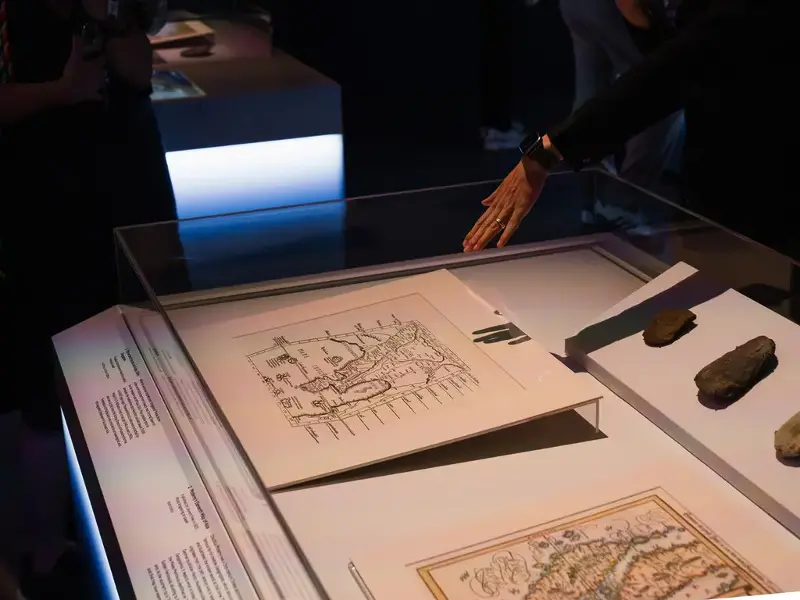
But upon taking a close—and I do mean close—look at the southern tip of the peninsula, you can also spot the words Sabana Emporium, the name of a trading post that could refer to Singapore…or anywhere else in the area. Truth be told, nobody truly knows what the label truly means, but that also means no one can say for certain that it doesn’t refer to Singapore–so as long as there’s delusion, there’s hope!
Anyway, for something a little bit more concrete, check out the View of the Town and Roads of Singapore from the Government Hill–a published drawing of what Singapore looked like from what we now know as Fort Canning Hill. As one of the earliest sketches on—and of—the island itself, you get no points for identifying it.
However, if you do want to put that skill to the test, then try out the digital Find Your Singapore game, where you can do exactly that: hunting for our island across various historical maps. But don’t worry if you’re not a geography nerd: you might actually learn even more since the game gives you explanations about your incorrect guesses.
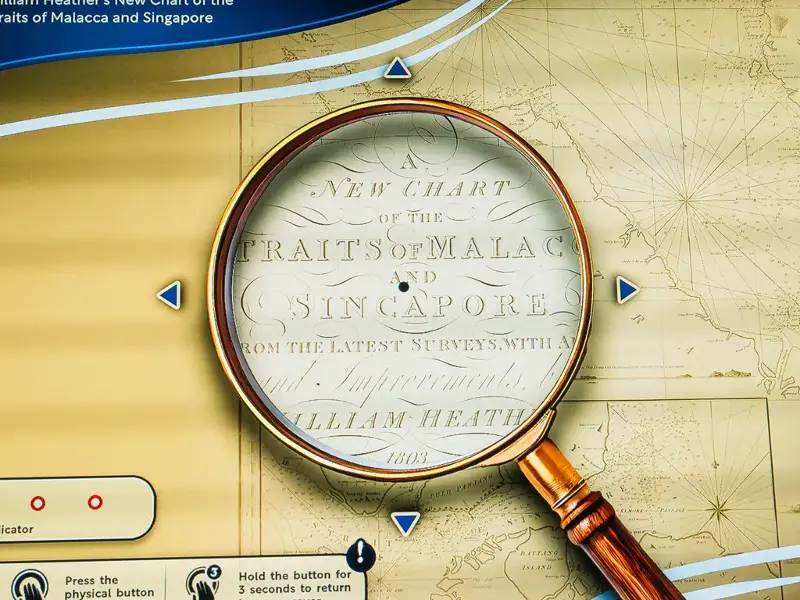
Chapter Two: The River Road
Sailing into The River Road, this chapter ponders over the place of the Singapore River in our nation’s history. Once the lifeblood of our early settlement, the river’s own evolution has since gone on to mirror our story of economic development. That’s why, for my first pick, I’ve chosen the straightforwardly titled Singapore by John Turnbull Thomson–a painting that shows we’ve always been an international hub.
In this rare piece, numerous vessels of various origins are depicted—including imposing East Indiamen merchant ships from Britain and the Netherlands, a dinky Siamese junk, and other regional Malay boats—making this a boat-watcher’s literal wet dream. The invisible brushwork of the cloudy sky is incredibly impressive as well, and it provides a fitting backdrop to the rows of warehouses and shophouses lining the Singapore River.
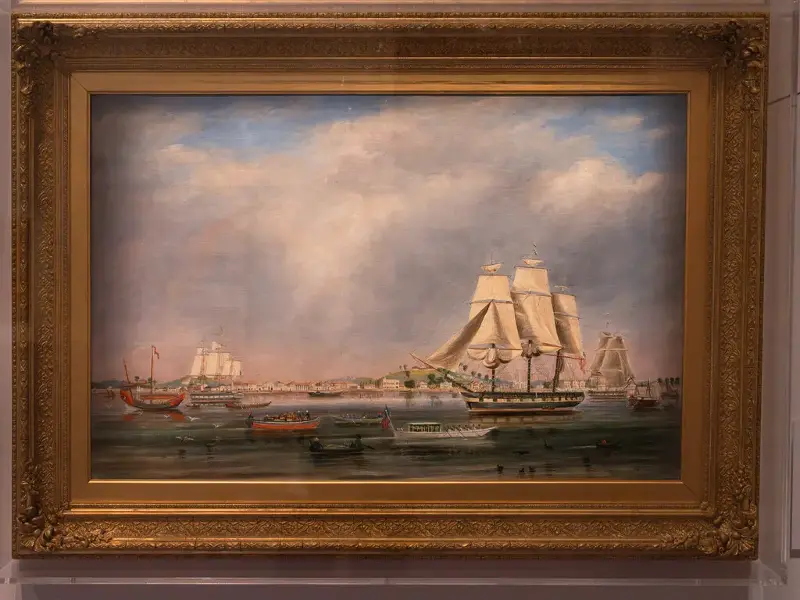
Finally, it’s also one of 11 artworks with Waves of Wonder captions. These explanations—fit in cute booklets located at kid-friendly heights—come bite-sized and with a mission-based activity to encourage children to get curious about the artefacts. For Singapore, that’s locating all of the aforementioned ships I told you about, and honestly–I had a blast reading this too!
And for some more added fun, take on the Sampan Challenge and row across the Singapore River, skillfully navigating past other vessels and battling the elements to safely deliver your passengers to their destination. Now, while I may be a terrible canoer in real life, I’m actually a beast at this game–reaching the finish point with more than enough seconds to spare.
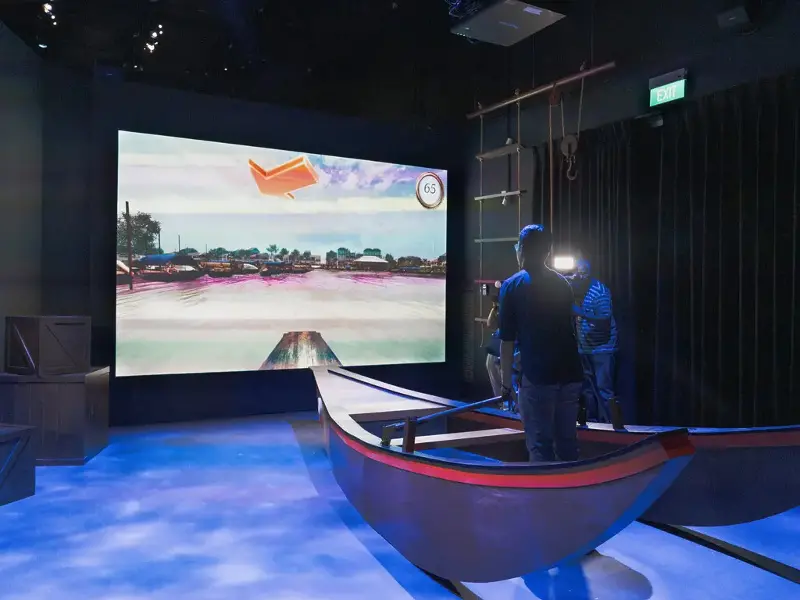
Chapter Three: Expanding Horizons
Even though we’re not technically done with the previous chapter, we’re still taking a dip out of the river since—just like the waterway itself—the exhibition space has been designed to branch off into two tributaries for the next two chapters, the first of which is Expanding Horizons.
Here, this section sheds light on Singapore’s rigorous focus on creative land planning to overcome the inherent restraints of our limited physical size, and how, contrary to popular belief, land reclamation isn’t a modern invention, but rather one that goes back into the colonial times.
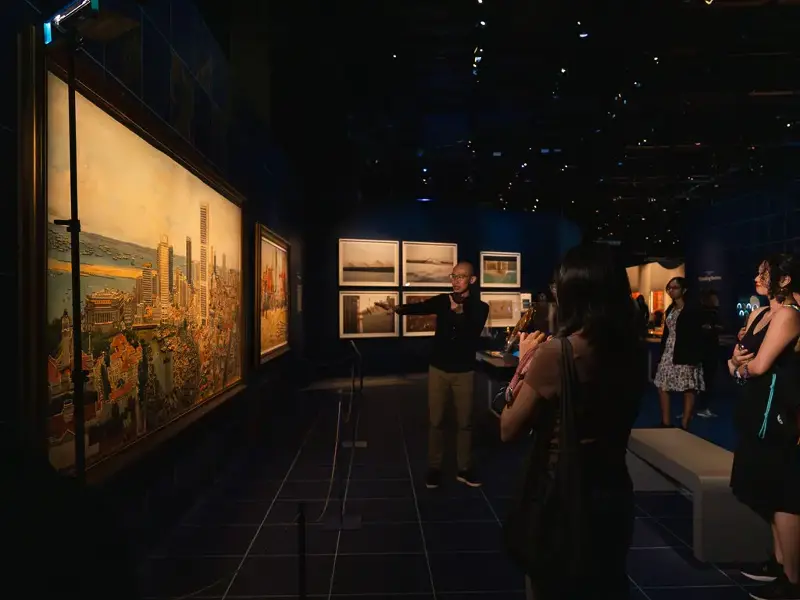
From Sir Stamford Raffles’ adorably passive-aggressive letter to a trading company about being “sorry to discover” they were building in a “very objectionable” place, to Lai Kui Fang’s breathtaking bird’s-eye and on-the-ground paintings of the Singapore skyline in 1976, there’s so much to point out in this considerably condensed chapter.
But if I could only explain my love for one artefact, then I’d have to meet history halfway and go with the early 1970s physiographic map of Singapore from Lee Kuan Yew’s Istana office.
Besides marking out areas of recent reclamation as well as those proposed for plans, this map is also special for what it doesn’t show–like the claw-like protrusion of Tuas, an extension of the island’s western end that’s still being reclaimed till this day.
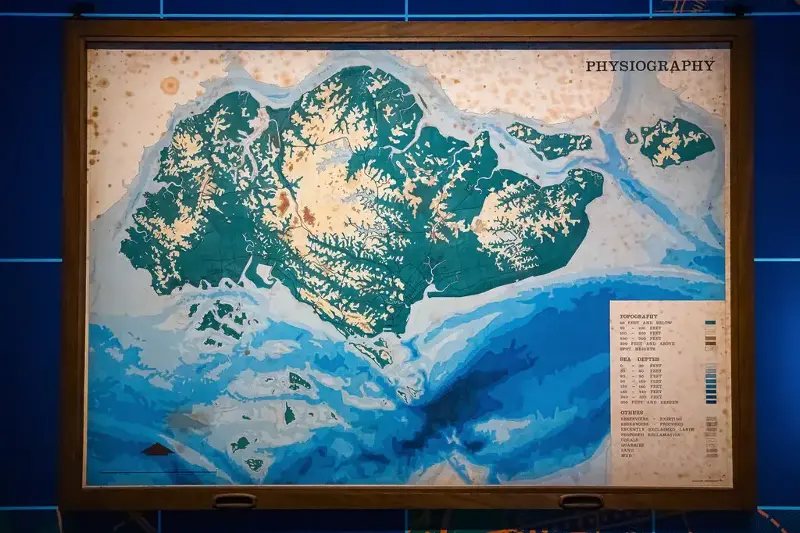
Chapter Four: Flows of People
Though what is a land without its people? In Chapter Four: Flows of People, the exhibition looks at the development of our early society and how—as previously mentioned—Singapore has always been multicultural right from the start.
Whether it’s through intimate artefacts, video testimonials, or personal mementoes, there’s plenty to take in about the tools of the trade and the slices of diversity that built the whole of our nation. That includes a diorama depicting a coolie room from the 1900s, which reveals intricate details about their living quarters–where they rested, dined, and even smoked opium.
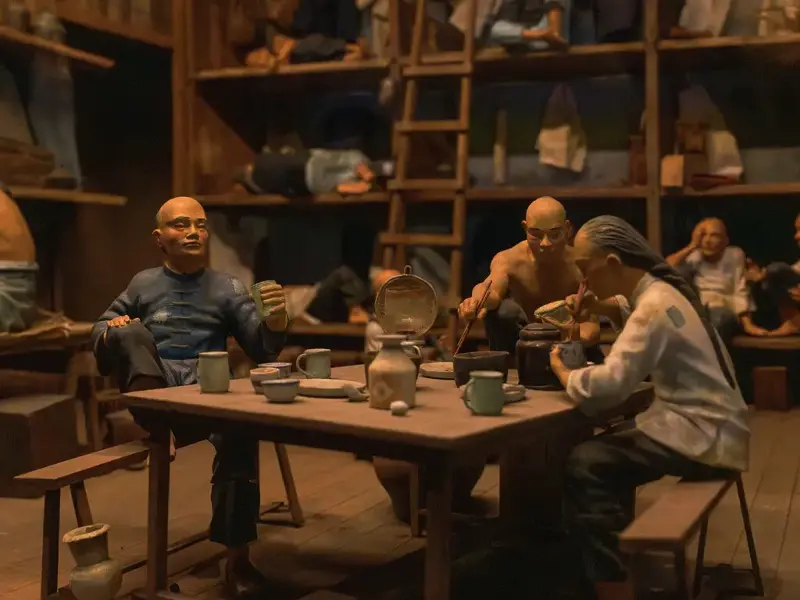
This section also draws parallels between equivalent occupations of the past and present using photographs, and it’s here where an image from Edwin Koo’s Foreign Worker Housing series strikes me, both visually and emotionally. It’s clearly unstaged, and likely captured in the spur of a moment too–showing shirtless workers in their dorms, surrounded by racks of laundry. Yet, there’s a raw, unfiltered beauty to it.
Strangely, in the many dialogues we Singaporeans have had about foreign workers—be it about CECA, lorry ferrying, or even the topic of living conditions that inspired this photography series—we, ironically, rarely hear from the workers themselves. And while this work still doesn’t feature their direct voices, as the saying goes, a picture speaks a thousand words.
So, looking back at the diorama and then at this image, the question I had in my mind was not “what has changed,” but rather “what has remained?” The fact that a nation continues to grow largely thanks to migrants? The possibility that, just like their predecessors, said nation will only commend them after their work is done and their hair is grey?

Chapter Two: The River Road, Continued
Arising from the streams of the last two chapters, we return once again to where we left off on The River Road. And as we move on from its colonial and crossroads past to a more commercial present, the next artefact I’m highlighting feels especially encapsulating of the new role the Singapore River would eventually come to play with the advent of steamships.
Quick: What’s the country with the longest railroad line in the world? If you said Russia, then congratulations–you’re correct. The Trans-Siberian Railway is now an astonishing 9,289 kilometres long, and as part of the inauguration for its establishment, the future Russian Emperor Nicolas II travelled from one end of his country to the other by sea, making stops at major ports across Asia along the way.
And as luck would have it, Singapore was one of those ports! Upon his arrival, he presented an opulent commemorative cigarette case of gilt silver, cabochon sapphire, and diamond to Master Attendant C. Q. G. Crauford–the government official responsible for managing shipping and promoting trade in our port.
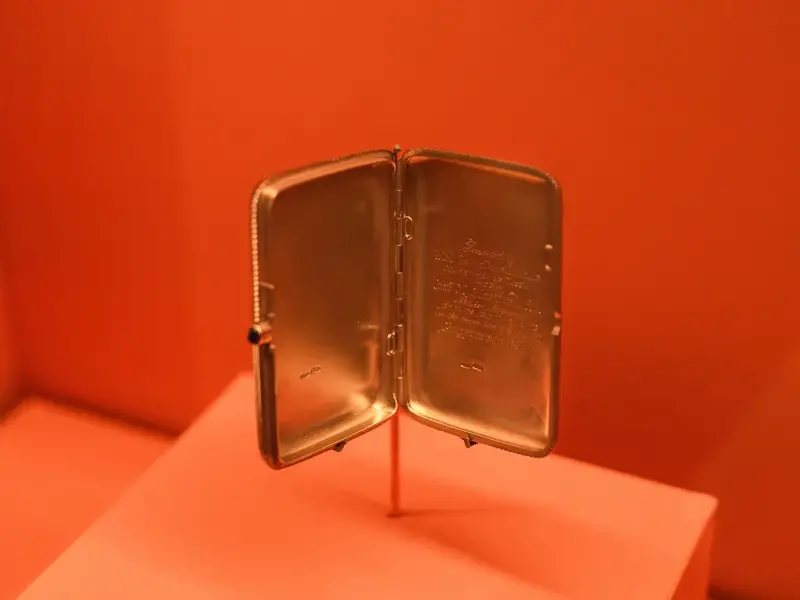
The then-Czarevitch’s grand tour thus reflects Singapore’s position as a key maritime hub for not only business, but also tourism. The cigarette case also highlights the Master Attendant’s vital role in representing the nation, and that itself underscores how central the river is to that position.
Ultimately, it’s a real shame he didn’t hand out more lavish gifts while he was here since, much like a cigarette, Nicolas II got smoked before he could ever return…but that’s a history lesson for another time.
Besides that grim artefact, though, I’d recommend the more hopeful Fresh Waters, New Beginnings as well, a video documenting the river’s extraordinary transformation from a functional yet filthy waterway to a clean and green destination in just ten short years.
And since you’re there already, you can’t miss the lengthy Singapore Panorama next to the video, a drawing by autistic British artist Stephen Wiltshire, who created this entire work from memory after a single hour-long helicopter ride over Singapore.
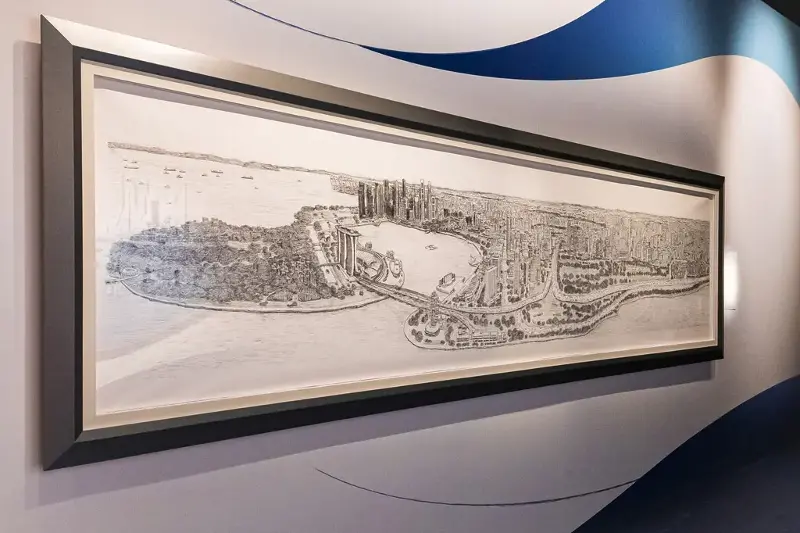
Chapter Five: Making Waves
At last, we docked at Making Waves, the final chapter and penultimate section of the exhibition. This section spotlights Singaporeans who have made waves globally across multiple fields from independence in 1965 to the present day.
It includes a diverse range of artefacts documenting achievements in these aforementioned fields, not just in sports and arts, but also in diplomacy and humanitarian efforts. Personally, my top favourite has to be the pair of North Korea-United States 2018 Summit security passes, because honestly, I still can’t believe it started with a war of words on Twitter–where one called the other “short and fat,” and the other fired back by calling him a “dotard.”
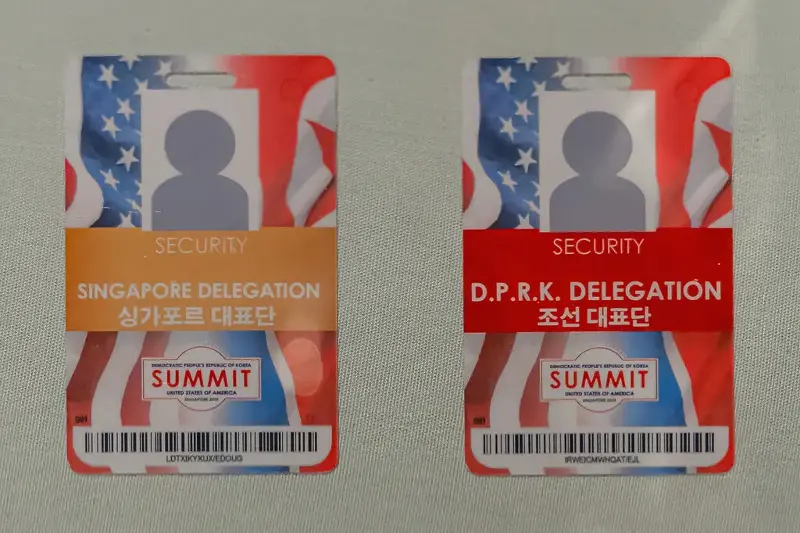
Apart from these sobering reminders that we helped prevent nuclear armageddon as the world knew it, the section also features an interactive Singlish quiz near its end, celebrating the numerous words of our creole that have made it into the Oxford Dictionary while testing your knowledge of them.
Plus, if you feel inspired by the showcase of stories and objects in this collection, you should be glad to know that the museum invites you to contribute your own “wave maker” artefacts as part of its Collecting Contemporary Singapore initiative. The contributions will help the National Museum build up its collection and tell more diverse tales of Singaporeans who make us proud globally, and more information about this public call is available on its website.
Conclusion
Finally, we conclude Once Upon a Tide with the assignment of one of four avatars based on the responses given throughout the light-hearted questions interspersed across the exhibition sections and answered using the RFID wristbands provided at the start.
As each avatar reflects one’s individual values, priorities, and aspirations for Singapore’s future, you’ll be able to watch your avatar as they’re sent to a larger cityscape visual that represents the collective vision of Singapore’s tomorrow, co-created by all who participate!

Overall, Once Upon a Tide: Singapore’s Journey from Settlement to Global City is a timely summary of our island’s history through the swimming goggles of its river and sea. And while it’s by no means a comprehensive review of our past and present, I find that what it’s trying to show instead—namely the trends of our transformation—is more of an exciting glimpse at our future.
So, if you’re ready to make like an explorer and to discover the rest of the highlights waiting beneath the waves, take a voyage to this exhibition at the National Museum of Singapore today!
🗓Date: 24 May 2025 to 09 Oct 2026
📍Location: National Museum of Singapore, 93 Stamford Rd, Singapore 178897
💲Price: Free for Singaporeans and PRs
⏰Time: 10am to 6:30pm
For more updates about the museum and its offerings, check out its official website and follow its socials on Instagram and TikTok. With that, I got a ship to catch back home now, so I’ll see you at the next National Museum exhibition!
Photos by Heng Yu Cheng of the DANAMIC Team. Additional visuals courtesy of the National Museum of Singapore.
